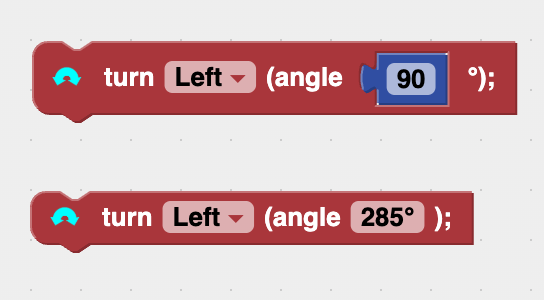Students will be able to:
|
|
Turn Left and Right In this lesson, you will learn how to use the turn blocks in RoboBlocky to make a robot turn left or right by a specific number of degrees. This video explains two types of turn blocks: one that uses a number block to enter the number of degrees the robot will turn, and another that uses a unit circle dial to select the number of degrees visually.
The turn code blocks allow a robot to turn left or right by a specified number of degrees. 
There are two types of turn blocks. The first turn block lets you choose the direction using a drop-down menu and enter the exact number of degrees directly into a blue number block. This is helpful when you want the robot to turn a precise number of degrees, such as 37 or 122 degrees.
The second turn block also includes a direction drop-down menu, but uses a unit circle dial to set the turn angle. Click the number input to open the dial, then move your mouse around the circle to choose an angle and click to confirm. The dial ranges from 0 to 345 degrees, with tick marks every 15 degrees. The dial makes it easy to select common turn angles, like 45, 90, 180, or 270 degrees, and helps you better visualize how far the robot will turn. 
|
|
The example turns the robot left for 90 degrees and then right 180 degrees using Turn blocks. |
The example drives the robot to the red dot, then the green dot using driveDistance and Turn blocks. |
| The example starts the robot from a new location and drives it to the red dot, then the green dot using driveDistance and Turn blocks. |



